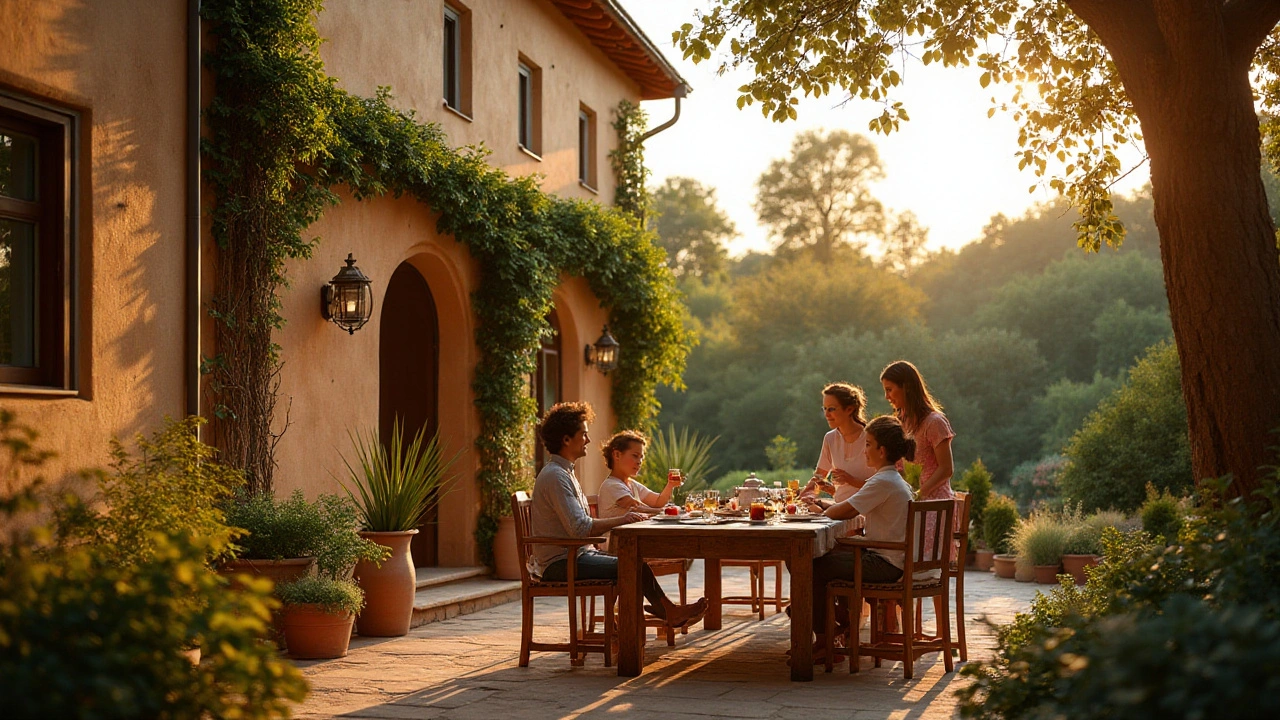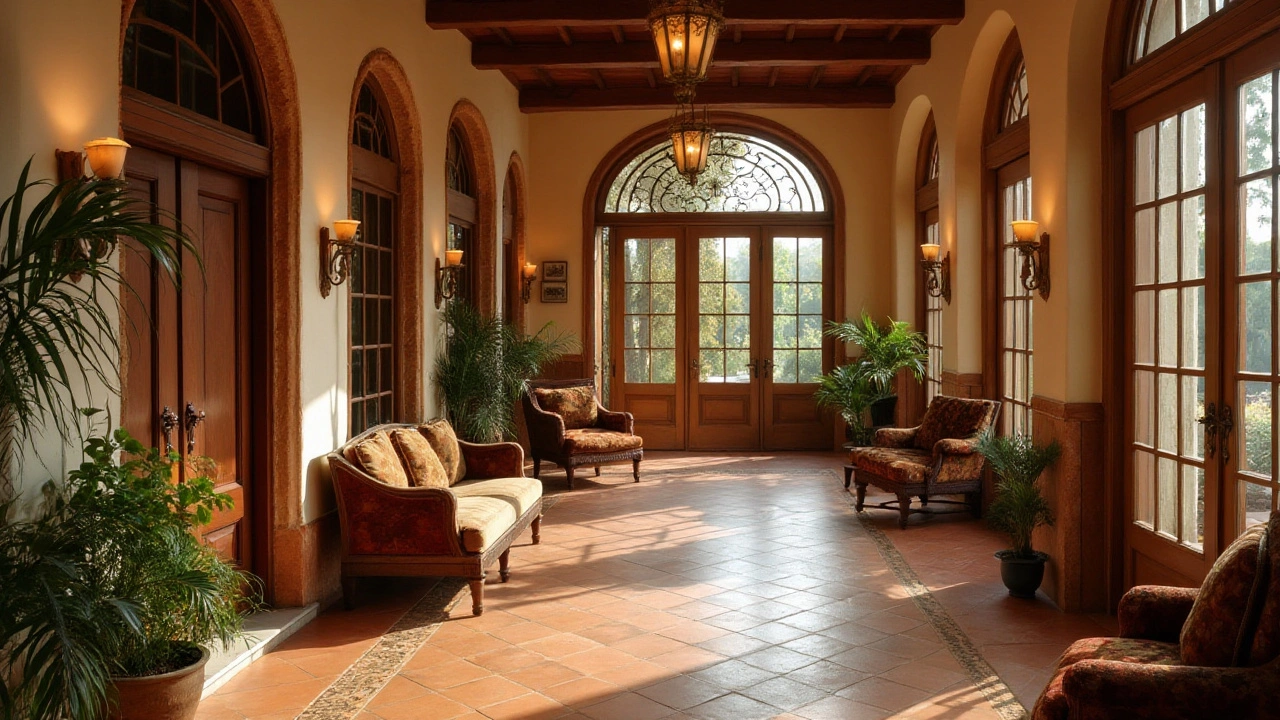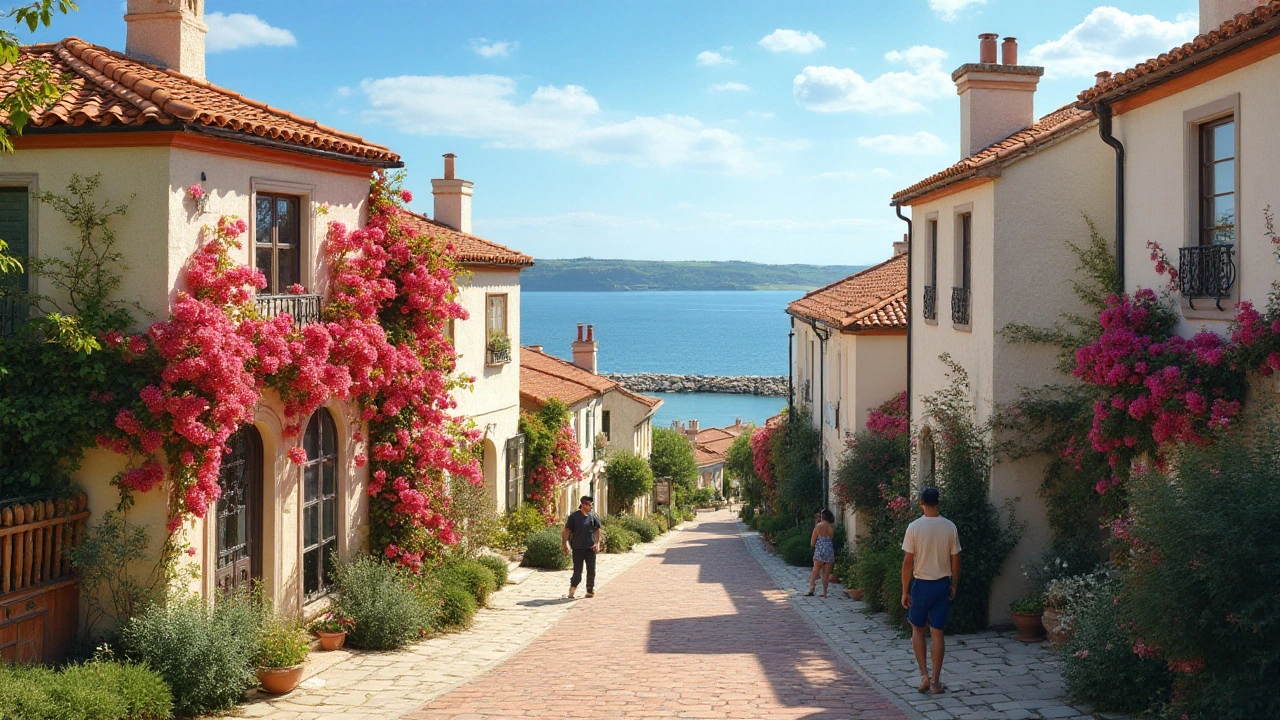Mediterranean Revival Architecture: Unraveling Its Timeless Appeal
 Nov, 4 2024
Nov, 4 2024
Mediterranean Revival Architecture has enchanted admirers for decades with its distinctive blend of old-world charm and inviting aesthetics. Rooted in the picturesque landscapes of Southern Europe, this architectural style offers a timeless approach that exudes elegance and warmth. Whether you're walking along a sunlit coastal town or exploring a quaint neighborhood, Mediterranean Revival homes are sure to catch your eye with their signature features.
Step back in time to uncover the historical origins of this appealing style and understand what makes it so unique. The elements of Mediterranean Revival are not just about aesthetics; they are a celebration of cultural influences that have seamlessly blended into a harmonious design.
In today's world, where design trends come and go, Mediterranean Revival continues to stand strong with its versatile and practical approach to modern living. Whether you are considering a new home project or simply curious about the style, there are various ways to bring this architectural charm into your own space.
- Historical Background
- Key Design Elements
- Cultural Influences
- Modern Adaptations
- Tips for Homeowners
Historical Background
The origins of Mediterranean Revival Architecture can be traced back to the early 20th century when architects in America sought inspiration from the reminiscent charm of European coastal towns. The style, primarily celebrated in the sunny regions of Florida and California, sought to recreate the breathtaking coastal living witnessed all across the Mediterranean Sea. But the inception was more than just aesthetic; it was a rebellion against the industrial brutality of the time. As the industrial revolution changed landscapes, architects yearned for a style that emphasized relaxation and a connection to the natural world.
During these transformative years, the Panama-California Exposition of 1915 played a pivotal role in popularizing the Mediterranean Revival style. The exposition displayed a myriad of architectural designs that included Spanish, Italian, and Moorish influences. For many, it was their first encounter with the stucco walls, clay tile roofs, and arched windows that are synonymous with the style today. Gerald L. Larson, a renowned architect, once said, "This architecture embodies the romance and tranquility that people were longing for in an era of great change."
The period known as the "Roaring Twenties" was particularly influential in propagating this style across the affluent communities in coastal America. Homes were built to mimic European villas, bringing the allure of a Mediterranean vacation to a homeowner's backyard. Such development wasn't just limited to residences. Theatres, universities, and public buildings borrowed elements from Mediterranean Revival, exemplifying the broad appeal and flexibility of the style.
Despite its deep roots in the past, this architectural style found a unique resonance that transcended eras, adapting smoothly into new-world urban environments. The seamless blend of aesthetics and functionality meant that Mediterranean Revival principles became favorites among architects for diverse projects. The energy-efficient features, like thick walls and small windows to keep houses cool, were a boon for warmer climates, thus ensuring their relevance even in today’s eco-conscious architecture trends.
In terms of numbers, by the 1930s, Mediterranean Revival had fast become a dominant style within the United States, accounting for a significant portion of new residential architecture. A cultural movement sparked by deep artistic appreciation and the economic boom brought a taste of Europe to American shores, a testament to its timeless appeal. Today, the ripple effects of this historical movement can still be felt as these iconic features continue to inspire contemporary designs, resonating with those keen to escape the mundane and embrace an inviting and relaxed lifestyle.
Key Design Elements
Mediterranean Revival Architecture is characterized by its distinctive, elegant features that capture the essence of coastal life from regions like Spain, Italy, and Greece. At the heart of this style are stucco walls, typically painted in warm earthy tones like terracotta, sandy beige, or calming whites, which not only reflect the sunlight but also evoke a sense of warmth and tranquility. Stucco, a durable and versatile material, is often paired with a familiar red-tiled roof. These tiles, reminiscent of sun-drenched landscapes, are typically made from clay and boast a beautiful curvature that contributes to the pleasing aesthetic while also being practical in nature, as they help maintain cooler temperatures inside homes.
Another unmistakable feature is the inclusion of large arched windows and doors, which play a dual role of enhancing beauty and functionality. Arched windows allow ample sunlight to flood the interiors, creating bright and inviting spaces. They are often paired with wooden shutters painted in vibrant colors, offering a Mediterranean splash to the facade. Arched doorways often have wrought iron detailing or grilles, handcrafted with swirling motifs echoing the style's rich history. This consistent use of wrought iron extends to stair railings and balconies, adding an intricate charm that is both rustic and refined.
Interiors of Mediterranean Revival homes prominently feature open floor plans, promoting a flow between indoor and outdoor spaces. This integration is a nod to the Mediterranean lifestyle where life seamlessly transitions between the two. Tiles, often ornate and rich in patterns, pave the floors. These tiles, whether in terracotta, mosaic, or simple geometric forms, are a testament to the artisanal skills from the Mediterranean region. Exposed wooden beams, sometimes whitewashed or left in their natural glory, dot the ceilings, adding a layer of rustic appeal while providing a contrast to the vibrant tiles below.
One cannot ignore the landscaped courtyards and gardens that accompany Mediterranean Revival homes. These spaces, often lush with olive trees, citrus plants, and fragrant herbs, form an integral part of the architecture. Water features like fountains are common, adding the gentle sound of trickling water to the serene environment. Courtyards are enclosed, offering privacy and a dedicated space for social gatherings or quiet reflection. It's the merging of architecture with nature, creating a sanctuary intertwined with the natural world.
When talking about this fascinating architectural style, an insightful comment from renowned architect Paul Williams comes to mind:
"Design is not just what it looks like, design is how it works."This can be aptly applied to Mediterranean Revival, where form truly meets function. The aesthetic allure pairs harmoniously with functionality, providing not only a feast for the eyes but also comfort and practicality. These homes are crafted to be lived in and cherished, embodying a sense of history and tradition that resonates with many.

Cultural Influences
The splendor of Mediterranean Revival Architecture lies not only in its aesthetic appeal but also in its rich cultural tapestry woven across centuries. This architectural style is a symphony of influences from countries bathed in the Mediterranean sun, each contributing its unique notes to the ensemble. From the S-shaped scrolls of Spanish courtyards to the minimalist allure of Greek island dwellings, the Revival style encapsulates an eclectic mixture of elements. These contributions stem from a diverse range of cultural traditions, making Mediterranean architecture not just a design choice but a journey through history and geography.
One cannot overlook the significant impact of Italian Renaissance architecture on this style. With its splendid villas and grandiose palazzos, Italy has long been a muse. The seamless integration of the indoor and outdoor spaces, a hallmark of Italian design, finds a cherished place in the Revival style. This is not merely about merging spaces but creating fluidity that reflects the Italian way of life where nature is an extension of the home. It is no surprise that in many Mediterranean Revival homes, you will find lush gardens and inviting patios that echo this sentiment.
Spanish Colonial architecture also plays a pivotal role in shaping the Mediterranean Revival style. Originating from Spanish settlers in the Americas, this style is known for its stucco facades and red-tiled roofs, which have become iconic in Mediterranean designs. The use of courtyards as central gathering places is an element borrowed from this tradition, enhancing the social and communal aspects of Mediterranean living. This influence results in homes that are inherently welcoming and designed for both intimate and expansive gatherings, a testament to the warm hospitality intrinsic to Mediterranean cultures.
Greek architecture contributes simplicity and balance, with a focus on symmetry and proportion that are integral to many Mediterranean architecture designs. This influence often manifests in the revival style through the use of arches and columns, invoking the ancient splendor of Greek temples. These elements not only serve aesthetic purposes but also bring a structural grace that has endured throughout centuries, a nod to Greece's architectural legacy of timeless beauty.
"The Mediterranean culture places a strong emphasis on social interaction and connectivity, and this is brilliantly reflected in its architectural designs," notes historian Leah Marcus, whose work delves into the influence of Mediterranean traditions on modern architecture.
Beyond individual countries, the Mediterranean Revival Architecture draws from a region characterized by its diversity, where trade routes were avenues for the exchange of ideas and styles. The cross-pollination of European, Moorish, and even Asian influences via these ancient routes underscore the hybrid nature of the Revival style. It is this very blending that lends Mediterranean architecture an unmatched elegance and adaptability, resonating with an array of personal tastes while remaining a celebration of cultural convergence.
Modern Adaptations
Mediterranean Revival architecture has not only endured the test of time but has also seamlessly evolved to meet modern demands while preserving its classic appeal. The secret to this enduring popularity lies in the style's inherent flexibility, allowing it to blend traditional elements with contemporary touches. One of the most striking modern adaptations is the incorporation of advanced sustainable design principles, which find a natural partner in Mediterranean architecture's emphasis on light and openness. Increasingly, architects are incorporating solar panels onto red-tiled roofs and designing homes to optimize natural light, making them energy-efficient without losing their old-world charm.
For modern homeowners, adapting Mediterranean Revival architecture to their living spaces means finding balance between the past and the present. The style's iconic stucco walls and arched windows are often updated with modern materials that offer enhanced durability and insulation. Inside, open floor plans replace some of the more segmented traditional designs, promoting a sense of openness and flow suitable for contemporary living. Placing emphasis on outdoor living spaces continues to be a hallmark of the style. Updated patios and terraces are tailored for both relaxation and entertainment, seamlessly extending the indoor living areas into the outdoors.
Many designers today emphasize the role of landscaping in maintaining the Mediterranean aesthetic. Cultivating botanical elements such as olive trees, lavender, and drought-resistant plants offer both beauty and practicality while also supporting environmentally conscious design approaches. This integration of lush greenery not only enhances the homes' curb appeal but also provides natural cooling, reducing the reliance on artificial climate control. The interplay of water features, like fountains which trace back their origins to lush Mediterranean gardens, continues to find a place in modern adaptations, adding both beauty and a cooling effect.
Leading architects herald the unique ability of Mediterranean Revival architecture to adapt to various climates and personal tastes. As noted by acclaimed designer Jane Smith in a 2023 interview,
"The essence of Mediterranean Revival is its adaptability. Its fundamental elements are timeless, yet they offer countless opportunities for personal expression and modern innovation."This adaptability has been further pronounced in urban settings where limited space requires innovative solutions that do not compromise on style.
Modern technology also plays a role in the style’s evolution. From smart home technology seamlessly integrated into rustic façades, to adaptive lighting solutions that enhance the ambiance of traditional courtyards, Mediterranean Revival architecture keeps pace with technological advancements without losing sight of its roots. Even kitchen and living areas boast the latest appliances and fixtures, while retaining the timeless character with warm earth tones and intricate tile work synonymous with the original style.
With its rich heritage and adaptable nature, Mediterranean Revival architecture remains an inspiring canvas for those seeking a harmonious blend of the traditional and the contemporary. It’s a testament to how the elegance of historical design can coexist with the innovations of modern life, continually captivating the imagination of homeowners and builders alike.

Tips for Homeowners
Embracing Mediterranean Revival Architecture in your own home doesn't require you to live along the sunny coasts of Spain or Italy. Its elegance and warmth can be integrated wherever you are willing to put a personal touch. One key aspect of bringing this style to life is through the choice of materials. Consider incorporating natural materials such as terracotta, which works wonders for tiles and roof accents. Stucco walls, another signature feature of Mediterranean design, can add depth and texture to any facade. Opting for warm earth tones like ochre, burnt sienna, and sandy hues can further evoke that sunny, timeless feel.
Lighting plays a crucial role in Mediterranean homes. Ample natural light adds a sense of openness, so it's best to have large, arched windows where possible. This not only connects the indoors with the outdoors but also serves to brighten the space gorgeously. When it comes to artificial lighting, consider wrought-iron chandeliers or lanterns which complement the rustic yet polished aesthetic. As the renowned architect Frank Lloyd Wright once said,
"Light is the beautifier, light is the purifier."Consider this statement when planning the layout and design of your space.
Incorporating outdoor living spaces that mirror Mediterranean life is another fantastic idea. Patios adorned with mosaic tiles, wrought iron furniture, and colorful pottery bring life and character to any garden setting. An emphasis on creating a seamless transition between indoor and outdoor areas can also enhance the appeal. Adding features like a courtyard or a Mediterranean-inspired pergola with creeping vines can create a perfect spot for summer gatherings or tranquil retreats.
What's more, embracing architectural charm through details can make a world of difference. Consider integrating intricate woodwork or rustic beams into your interiors for visual interest. Decorative tiles with patterns resembling the Mediterranean sea can be used as a backsplash in kitchens or bathrooms, making these spaces pop. And don’t forget about the landscaping; palm trees, olive trees, and aromatic herbs like lavender can evoke the fragrant atmosphere of a Mediterranean getaway.
Moreover, if you're starting from scratch or renovating, take a cue from history. You'll find nuggets of inspiration in how traditional homes were built to maximize airflow and natural cooling, which is not only charm-laden but environmentally friendly. This aligns perfectly with today’s increasing move towards sustainable living. A smart irrigation system combined with drought-resistant plants can bring your garden to life while conserving water, perfect for those dry summer months.